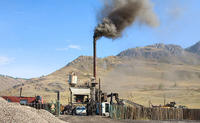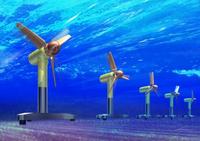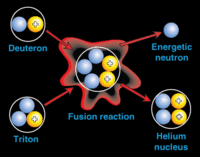-
Exploring asteroids for commercial metal harvesting

Deep Space says that in a decade, it will be harvesting asteroids for metals and other building materials, to construct large communications platforms to replace communications satellites, and later solar power stations to beam carbon-free energy to consumers on Earth. “More than 900 new asteroids that pass near Earth are discovered every year. They can be like the Iron Range of Minnesota was for the Detroit car industry last century,” says the company’s CEO.
-
-
Uranium mining debate divides Virginia
In Virginia a fight has begun over whether to drill for uranium. Some feel the drilling, which would create about 1,000 jobs and bounty of tax revenue in addition to nuclear fuel, is important for a state whose main industries, such as tobacco and textiles, are failing. Those who oppose the drilling fear the contamination of drinking water in case of an accident, and a stigma from uranium which would deter people and businesses from moving to the area.
-
-
Keystone pipeline clears another hurdle as Nebraska governor approves project
On Tuesday, Nebraska governor Dave Heineman notified President Obama that he approved the controversial Keystone XL pipeline to go through the state. This marks a significant step forward in the project, which was delayed by the administration last year.
-
-
Fracking generates less wastewater per unit of gas, but more overall
Hydraulically fractured natural gas wells are producing less wastewater per unit of gas recovered than conventional wells would. The scale of fracking operations in the Marcellus shale region – which stretches from New York to Virginia and accounts for about 10 percent of all natural gas produced in the United States today — is so vast, however, that the wastewater it produces threatens to overwhelm the region’s wastewater disposal capacity.
-
-
Large amounts of antibacterial agent used in soaps found in freshwater lakes
When people wash their hands with antibacterial soap, most do not think about where the chemicals contained in that soap end up. A new study determined that the common antibacterial agent, called triclosan, used in soaps and many other products, is found in increasing amounts in several Minnesota freshwater lakes.
-
-
DOE addresses rare earth, critical materials shortage
The U.S. Department of Energy announced earlier this month that a team led by Ames Laboratory in Ames, Iowa, has been selected for an award of up to $120 million over five years to establish an Energy Innovation Hub which will develop solutions to the domestic shortages of rare earth metals and other materials critical for U.S. energy security.
-
-
Thorium holds promise of safer, cleaner nuclear power
Thorium as nuclear fuels has drawbacks, but its main advantage includes generating far less toxic residue. The majority of the mineral is used during the fission process, and it can burn existing stockpiles of plutonium and hazardous waste, saving the need to transport it and bury the waste in concrete. If thorium becomes available as a source of energy in the future, the world will rely less on coal and gas, and wind turbines will become a thing of the past. The risk of a global energy crunch will decrease considerably.
-
-
Black carbon’s contribution to climate change underestimated
Black carbon is the second largest man-made contributor to global warming and its influence on climate has been greatly underestimated, according to the first quantitative and comprehensive analysis of this issue; black carbon is believed to have a warming effect of about 1.1 Watts per square meter (W/m²), approximately two thirds of the effect of the largest man made contributor to global warming, carbon dioxide.
-
-
Black carbon’s contribution to climate change underestimated

Black carbon is the second largest man-made contributor to global warming and its influence on climate has been greatly underestimated, according to the first quantitative and comprehensive analysis of this issue; black carbon is believed to have a warming effect of about 1.1 Watts per square meter (W/m²), approximately two thirds of the effect of the largest man made contributor to global warming, carbon dioxide.
-
-
NASA: 2012 sustained long-term climate warming trend
NASA scientists say 2012 was the ninth warmest of any year since 1880, continuing a long-term trend of rising global temperatures. With the exception of 1998, the nine warmest years in the 132-year record all have occurred since 2000, with 2010 and 2005 ranking as the hottest years on record. Scientists emphasize that weather patterns always will cause fluctuations in average temperature from year to year, but the continued increase in greenhouse gas levels in Earth’s atmosphere assures a long-term rise in global temperatures. Each successive year will not necessarily be warmer than the year before, but on the current course of greenhouse gas increases, scientists expect each successive decade to be warmer than the previous decade.
-
-
Nuclear-powered deep space rockets

In the 1960s the federal government tested nuclear rocket technology for the flights following the Apollo moonshots. The Los Alamos National Laboratory in New Mexico set up Project NERVA (Nuclear Energy for Rocket Vehicle Application). The concept was to use a nuclear reactor to blast a rocket out of Earth’s orbit. Concerns about safety and cost put an end to the project in 1973, but now there are some it is time to revisit the concept of nuclear rockets for deep space exploration.
-
-
The untapped potential of tidal power

New research from a global group of scientists and engineers has been published in a special issue journal of the Royal Society. The work is in support of tidal power, which has the potential to provide more than 20 per cent of the U.K. electricity demand. While the predictable nature of tides makes them an ideal renewable energy source, more so than wind, the ability effectively to harness energy from the tides has so far proved elusive.
-
-
Global demand for food and energy is growing, and so does land and water “grabbing”

As world food and energy demands grow, nations and some corporations increasingly are looking to acquire quality agricultural land for food production. Some nations are gaining land by buying up property — and accompanying water resources — in other, generally less wealthy countries.
-
-
The humble jute serves as a sustainable reinforcement for concrete
Fashionable people may turn up their noses at jute, the cheap fiber used to make burlap, gunny sacks, twine, and other common products, but new research is enhancing jute’s appeal as an inexpensive, sustainable reinforcement for mortar and concrete.
-
-
New design for clean nuclear fusion reactor unveiled

Researchers have patented a nuclear fusion reactor by inertial confinement which, in addition to being used to generate electric power in plants, could be applied to propel ships. The fusion chamber shape and size can adapt to the type of fuel being used.
-
More headlines
The long view
Water Wars: A Historic Agreement Between Mexico and US Is Ramping Up Border Tension
As climate change drives rising temperatures and changes in rainfall, Mexico and the US are in the middle of a conflict over water, putting an additional strain on their relationship. Partly due to constant droughts, Mexico has struggled to maintain its water deliveries for much of the last 25 years, deliveries to which it is obligated by a 1944 water-sharing agreement between the two countries.
Trump Is Fast-Tracking New Coal Mines — Even When They Don’t Make Economic Sense
In Appalachian Tennessee, mines shut down and couldn’t pay their debts. Now a new one is opening under the guise of an “energy emergency.”
Smaller Nuclear Reactors Spark Renewed Interest in a Once-Shunned Energy Source
In the past two years, half the states have taken action to promote nuclear power, from creating nuclear task forces to integrating nuclear into long-term energy plans.
Keeping the Lights on with Nuclear Waste: Radiochemistry Transforms Nuclear Waste into Strategic Materials
How UNLV radiochemistry is pioneering the future of energy in the Southwest by salvaging strategic materials from nuclear dumps –and making it safe.
Model Predicts Long-Term Effects of Nuclear Waste on Underground Disposal Systems
The simulations matched results from an underground lab experiment in Switzerland, suggesting modeling could be used to validate the safety of nuclear disposal sites.
